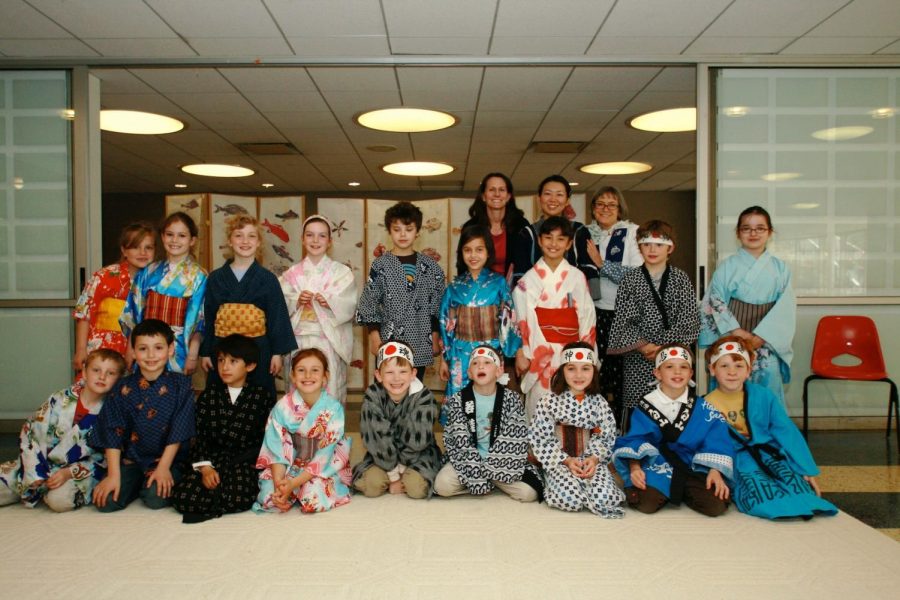Evolving Traditions
Lower School Continues to Evaluate Cultural Appropriation in Curricula
Members of the current class of 2018 pose in yukatas following their Japanese program in Kathy Wild’s second grade class. Photo courtesy of Liz Cicchelli.
Ten years ago, Woodland People’s Day at Parker was a third grade event, a culmination of the grade’s study of Native Americans and Native American culture. Eight-to-nine-year-olds dressed up in sheets brightly decorated with Crayola marker, generously applied “tribal” face paint to themselves and to each other, sang songs such as “Grinding Corn,” and participated in Native American-themed activities, such as archery, firestarting, storytelling in a wigwam, and dreamcatcher-making.
Since then Woodland People’s Day changed to Woodland Activity Day, which lacks the Native American role-playing of its predecessor. “It’s really more about how people lived and made their way in the world,” Lower School head Kimeri Swanson-Beck said. “We’ve really cut out a lot of the dressing up because it’s actually offensive. That was created because children learn by playing, but as adults, we have to not enforce the playing of a different culture.”
Lower and Intermediate School traditions such as Woodland People’s Day have existed for years, though many have undergone recent modifications to “adapt to the times,” according to first grade teacher Bev “Greenie” Greenberg.
The Egyptian Museum, a capstone tradition for the fourth grade’s study of Ancient Egypt, was altered three years ago. Students used to research a particular aspect of Ancient Egyptian culture–like mummification or mathematics–and present in a science fair-style gallery wearing typical Ancient Egyptian clothing: tunics for girls and shirtless for boys, with distinct eye makeup and decorated neck collars.
Fourth graders currently present their research projects in a similar fashion–but now dressed as museum docents.
For some who have experienced these traditions, it’s hard to see them change. “I get it, but at the same time, that’s not cultural appropriation because the Ancient Egyptians don’t exist anymore,” senior and 14-year Parker student Jai Choudhary said. “I think the school has the right to be sensitive, but I think they take it too far sometimes.”
According to Swanson-Beck, reevaluating Parker traditions can be difficult, especially because they’ve existed for so long. “We have to look at our traditions and think, ‘Why was this created, and how is it serving kids?’” Swanson-Beck said. “And if it’s no longer serving that purpose–even if it was our favorite thing to do–we’re probably going to change it.”
These kinds of changes to Lower School curricula and traditions began around eight years ago, when consultant Enid Lee came to Parker to “identify stereotypes perpetuated by the curriculum,” according to Swanson-Beck. Pushes to make curricula more inclusive were headed by former Lower School head Mary Ann Manley as well.
Other traditions have been changed for reasons other than cultural appropriateness. The Mexican Fiesta, a culmination of the first grade’s study of the country of Mexico, included food, singing songs in Spanish, dancing, and playing instruments while dressed in traditional Mexican clothing bought from Mexico.
“When we had the Mexican Fiesta, it was all about singing and dancing and celebrating the culture through song and dance,” Greenberg said. “It was not about ethnic stereotypes.”
The Fiesta was dropped when current Lower School Spanish teacher Daniel Baltierra started at Parker in 2008 and introduced a more comprehensive Lower School Spanish program. According to Greenberg, the Fiesta occurred too close to the end of the year and required a significant amount of work. The curriculum was also changing to include Baltierra, who was taking over the study of Mexico.
Had the Mexican Fiesta continued to this day, though, Greenberg believes it would’ve been stopped or at least modified. “We are all more aware,” Greenberg said. “Our country and our desire to be more respectful of what other people bring to the United States from their own ethnicities and cultures makes us more mindful of what we do with younger children.”
Some traditions are currently being evaluated. The second grade curriculum, for example, which focuses on the study of Japan, includes the Tea Room and Japanese program traditions.
Pairs of students get to spend a day in a Japanese “tea room” constructed in the back corner of the classrooms behind shoji screens, playing Japanese games and eating a Japanese lunch. Each class puts on their own Japanese program too, in which second graders perform a Japanese Noh play, sing Japanese songs, and recite haikus. For both events, students are dressed in yukatas, a summer kimono.
Second grade teacher Cathy Davidson thinks the wearing of yukatas is not inappropriate. “Because if you go to Japan, people do wear them at festivals and celebrations,” Davidson said. “We have to tell the kids that it’s a cultural and historical thing–and it’s still there. It’s still part of the culture.”
Swanson-Beck believes there’s a difference between dressing up for Woodland People’s day and wearing the Japanese yukatas. “It’s not really dressing up like people the same way,” Swanson-Beck said. “They wear yukatas, but they never try to be Japanese people. The goal is to be respectful and to see what it might be like to wear that kind of clothing, but never try to be that person.”
According to Davidson, consultant Dr. Derrick Gay, who will be working with the Lower School next year, attended one of the Japanese Theater performances this year. “It will be interesting to see what he took away from it,” Davidson said. “I think it’s worth defending, and we better be able to defend it, or we can’t teach it.”
With traditions that don’t involve historically marginalized and underrepresented cultures but still involve dressing up and portraying a person–like the third grade’s Pioneer School Day, the fourth grade’s Greek Play, and the fifth grade’s Medieval Fair–the school is considering how to proceed.
Greenberg emphasized the importance of adapting traditions. “I don’t think we should apologize for what we experienced in the times we were in,” Greenberg said. “When it worked then, times were different. It’s not a bad thing to let go of a tradition, and it’s not a bad thing to modify a tradition. It’s about what’s appropriate for the kids in the time they’re living now.”








